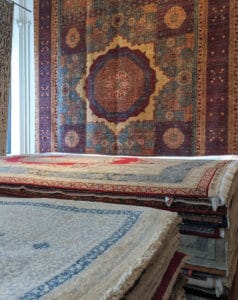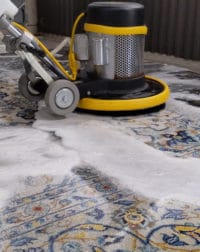Persian rugs are some of the most sought-after (and pricey) pieces of décor you can have in your home – but many people don’t know why they’re so exclusive.
To us, a Persian rug is just as amazing as a painting a fancy gallery. We’re continually awestruck by the beauty, craftsmanship, and imagination that goes into creating these pieces of art – not to mention the hours of hard work and dedication that each rug requires.
Here, we explain exactly what a Persian rug is and why they’re so expensive. Read on to learn how to care for and protect these incredible pieces, so you can keep them safe for generations to come.
If your rug (Persian or otherwise!) needs a comprehensive cleaning, remember that it should always be taken to an off-site facility in order for it to be properly cleaned and protected. Get in touch to book a rug cleaning service and learn how we can help.
What are Persian rugs?
Persian rugs have a history that goes back 2,500 years and spans the area formerly known as ‘Greater Persia’, which stretched from eastern Turkey all the way to western China. Today, if you see a ‘Persian rug’, it typically refers to a rug that has been woven by hand in Iran.
Because of their long and rich tradition, Persian rugs are one of the oldest and most well-known types of rugs. You’ll recognize the style instantly – they’re usually created in rich, earthy colors and jewel tones, featuring classic patterns like flowers, animals, jugs, and geometric shapes.
There are many different styles and varieties of Persian rugs. As the craft has been passed down through generations for centuries, the rugs are very specific and specialized based on the practices in the region where the rug is created.

Why are Persian rugs so expensive?
Persian rugs can cost thousands of dollars – in fact, in 2013, one was even sold at auction for over $33 million… Even us rug-fanatics do a double-take every time we see that number…
However, once you learn about the incredible efforts that go into making a Persian rug, the lofty price tags start to make a little more sense.

- Time: We’re not talking hours – it takes months (or even years) to make a Persian rug by hand using traditional weaving techniques.
- Technique: The rugs are created by hand, which involves weaving individual threads and twisting knots one-by-one – sometimes there are more than 1,000 knots per square inch.
- Quality materials: Persian rugs are typically made of wool, which means the materials must be harvested, hand-dyed, and processed before they’re ready to be turned into a rug.
- Unique detail: Each hand-crafted Persian rug is entirely unique – look closer and you’ll notice different colors and patterns that create a sense of depth, texture, and tone – all of that fine detailing takes time and specialized materials.
- Skilled craftsmanship: The people who make Persian rugs are masters at their trade and have spent their lives perfecting their specific craft in an environment that can’t be mimicked or replicated anywhere else in the world.
- Storytelling: Persian rugs are pieces of art that contain immense cultural significance, featuring imagery, colors, and patterns that are specific to the time and place of the rug’s creation. Some are designed beforehand, while others are improvised by the weaver.
How to care for Persian rugs
Now that you know how much heart and soul went into creating your Persian rug, you know how important it is to put the same level of effort into looking after for it.
Keep it safe
Keep your rug in a low traffic area where it won’t be exposed to heavy activity – if it’s walked on regularly or placed underneath heavy furniture, the fibres can grind down quickly, which causes the rug to become worn and damage more easily.
Clean it regularly
You should give your rug a ‘dusting’ with a vacuum or cleaning brush once a week. Depending on the style, material, and condition of your rug, the equipment you use will vary.

- For very delicate rugs: Don’t risk the vacuum – use a soft bristled brush and work very carefully in the direction of the pile.
- For thin pile rugs: Use your vacuum’s upholstery attachment on thin pile rugs – vacuum by hand in the direction of the pile using short, downward movements.
- For heavier woven rugs: Use the main vacuum attachment, but either turn the rotator wheel off or keep the pile setting high to avoid tangling the fibres. Work in the direction of the pile.
Watch out for scammers
Persian rugs need professional cleaning outside of your home – anyone who claims they can clean it at the same time they clean your carpets is a scammer.
In order to effectively clean the rug while maintaining its quality, we need to devise a custom cleaning plan using specialized equipment and treatment, based on the style of rug and its current condition.
When you invest in a Persian rug, you’re not only bringing great décor into your home – it’s beautiful artwork, unparalleled craftsmanship, and a true piece of culture.
When it’s time to give it a little extra TLC, you can trust us to treat your rug with the care and respect it deserves. Get in touch to learn more about our rug cleaning, repair, and restoration services.
Request a Quote
We’ll be in contact with you shortly to give you an estimate.
